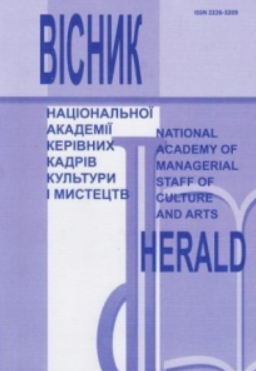СЦЕНІЧНИЙ КОСТЮМ: ЕВОЛЮЦІЯ ЗМІСТІВ У ХІХ СТ. (ЗА МАТЕРІАЛАМИ ТЕАТРАЛЬНИХ ТРУП ПІДРОСІЙСЬКОЇ ЧАСТИНИ УКРАЇНИ)
SCENIC COSTUME: EVOLUTION OF CONTENTS IN XIX (BY THEATRICAL TROUPES MATERIALS RUSSIA-BELONGED PART OF UKRAINE)
Author(s): Iryna Ivanivna NesenSubject(s): Theatre, Dance, Performing Arts, Cultural history, Customs / Folklore, 19th Century, History of Art
Published by: Національна академія керівних кадрів культури і мистецтв
Keywords: noble theater; folk theater; cultural revival; stage costume; traditional costume; synthesis of theatrical means;
Summary/Abstract: The purpose of the article consists of the definition of basic forms and stylistics of the scenic costume from the beginnings of appearance in Ukraine of professional theater till the end of the XIX century. The methodology of the research is based on keeping historiography tradition and interdisciplinary approaches because the historical context of research is connected to formal-stylistics analysis and the iconological method, which helps to discover the context of theatrical outfits and track symbols of time in it. The scientific novelty consists of the separation of main stylistic theatrical costume types which appeared and were used in theatrical practices in different time periods of the XIX century. Conclusions. Conducted research shows that since the moment when the first theaters appeared in Ukraine (the end of the XVIII century), there exist two style directions in the scenic outfits: aristocratic (french) and democratic (folk) types. The last is connected with folklore and calendar holiday traditions and was evolved in folk cultural revival context in Over-Dnieper Ukraine, which was started in 1798 by I. Kotlyarevsky‘s Aeneid. The traditional costume became the main component of the amateur period of the Ukrainian theater, which grew in the national repertoire (operas "Natalka Poltavka", "Zaporozhets over the Danube", the play "The Russian Magician", the drama "Nazar Stodolya"). It organically melted into a variety of folk costumes, which were made and used by Ukrainian troupes of professional theater in the period of 1882-1914. This costume became the face of the national poetic theater. The most important function of theatrical attire is its participation in the synthesis of means of revealing the characters of the play, its meaningful composition. In this synthesis, the costume functions in a chain of concepts: text, play, character, actor, role, image.
Journal: Вісник Національної академії керівних кадрів культури і мистецтв
- Issue Year: 2021
- Issue No: 1
- Page Range: 53-57
- Page Count: 5
- Language: Ukrainian

